Whether you're looking to reduce your personal carbon footprint or just stretch your budget, cutting down on the amount of food you waste in your home is a big step in the right direction. Most of us waste more than we think (if you weighed and wrote down what you throw out, like many restaurants do, you'd be shocked), and learning to reduce food waste is one of the most powerful things you can do as an individual. Here are 10 tips to get you started.
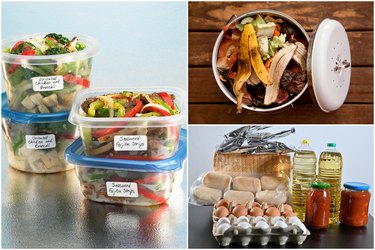
Video of the Day
1. First In, First Out
When it comes to minimizing food waste, you can learn a lot from the professionals. Restaurants organize ingredients on a system of "first in, first out" or FIFO, which just means organizing your food so you always use older things before newer things. Restaurants might label and date their ingredients, but you probably don't need to do that at home (though it helps). Just make sure when you're putting things away that you leave the old food front and center, and tuck the new stuff in behind. Whether it's your fridge, freezer or pantry, that usually does the trick.
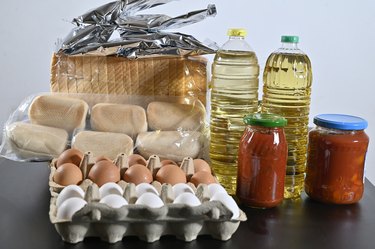 When you put away your groceries, make sure you’ll use the oldest first. Image Credit: Aitor Diago/Moment/GettyImages
When you put away your groceries, make sure you’ll use the oldest first. Image Credit: Aitor Diago/Moment/GettyImages
2. Think in Terms of "Planned-Overs"
Planning a holiday means, among other things, thinking about what you'll do with the leftovers. That's a skill you should be practicing all year long, so uneaten portions don't linger sadly in your fridge. It's surprisingly simple, once you get into the swing of it, and — because you'll already have a plan — takes away that "I dunno, what do you want?" moment each evening. Meat-and-potatoes meals can become pot pies or casserole ingredients, or a few days' accumulated vegetables and proteins can go into soups or frittatas or fried rice. After a few weeks, it'll become a natural mental habit.
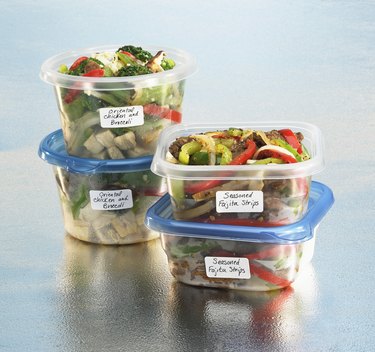 Meet the ingredients for your next meal. Image Credit: Image Studios/UpperCut Images/GettyImages
Meet the ingredients for your next meal. Image Credit: Image Studios/UpperCut Images/GettyImages
3. Make Broth or Stock
Broths and stocks are a versatile way to use up sad, forgotten vegetables, half-bunches of herbs and the bones and trimmings from meat and poultry. It's pretty simple: Drop them in a pot, simmer for a couple of hours, and then strain the result. Skim fat from the broth once it's been cooled in the fridge, then use it immediately in soups or sauces or else package it for the freezer. One- and two-cup portions make sense for most cooks, and you can also freeze some in ice cube trays. Use the broth to simmer meats and vegetables, or as part of the liquid when you're cooking rice. You'll add flavor and nutrition with minimal effort.
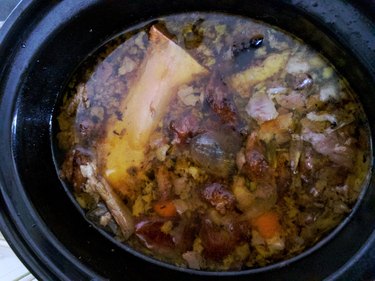 Turn your "orphaned" vegetables and leftover bones into flavorful broths and stocks. Image Credit: ©Daniela White Images/Moment/GettyImages
Turn your "orphaned" vegetables and leftover bones into flavorful broths and stocks. Image Credit: ©Daniela White Images/Moment/GettyImages
4. Freeze Extra Herbs
Herbs add bright, fresh flavor to a lot of recipes, but they're also chronic waste producers. Why? Because they're sold in large bunches, but most recipes only call for a tablespoon or two. Some, like oregano and rosemary, dry well, but most do not. Your best bet when you find yourself in this position, is to freeze them instead for long-term use. "Buzz" the herbs individually in a blender or food processor, or mince them finely by hand, and then blend or stir in enough oil to coat them. Packed into airtight bags, with the oil to protect them, they'll retain their fresh flavors for months.
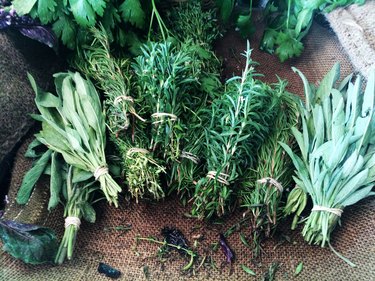 Freeze unused herbs to preserve their flavors. Image Credit: Geri Lavrov/Moment/GettyImages
Freeze unused herbs to preserve their flavors. Image Credit: Geri Lavrov/Moment/GettyImages
5. It's Not an "Expiration" Date
One of the biggest reasons people throw out perfectly good food is that it has "expired." Those "best before," "sell by" and "use by" dates are there for your guidance and convenience, but they don't mean the food is automatically unsafe after that date. They just indicate the producer's estimate of how long they'll be at their very best. As long as you've kept your foods cold and properly stored, the USDA says they're usually fine after those dates. In the case of shelf-stable pantry foods, they can last for years.
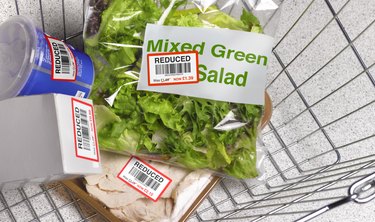 The dates on most foods simply provide guidance. Image Credit: Peter Dazeley/The Image Bank/GettyImages
The dates on most foods simply provide guidance. Image Credit: Peter Dazeley/The Image Bank/GettyImages
6. Schedule Regular "Fridge Diving" Days
It's always discouraging to find a container of moldy leftovers in the back of your fridge, or a pool of mushy "compost" at the bottom of your crisper drawer. You can avoid those unhappy surprises and reduce your food waste by scheduling one or two "fridge diving" days each week. Once each week is often enough to catch most ingredients before they go bad, and give you a chance to use them up. Most leftovers are good for 3 to 4 days in the fridge, so revisit those twice a week. It helps if leftovers have a designated spot in the fridge, where they're easy to find.
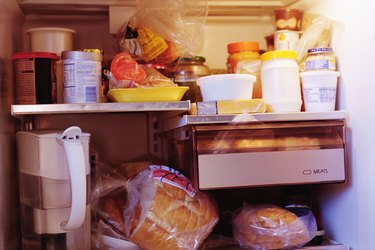 Checking your fridge frequently helps minimize the risk of "surprises." Image Credit: Thinkstock Images/Stockbyte/GettyImages
Checking your fridge frequently helps minimize the risk of "surprises." Image Credit: Thinkstock Images/Stockbyte/GettyImages
7. Use the Whole Thing
One of the best ways to reduce food waste is to take a long, hard look at the things you trim off and discard. Broccoli stems, for example, make up a big part of the head and they're just as good as the florets once you've removed the stringy skin. Washing your potatoes, carrots and apples instead of peeling them preserves much of their nutrition. Corn husks can be used to wrap tamales or fish for steaming, where they'll add flavor. The leafy portions of celery and carrots can be used as herbs to flavor your soups and salads, or as a tasty garnish on finished dishes. A bit of internet searching will turn up LOTS of additional suggestions.
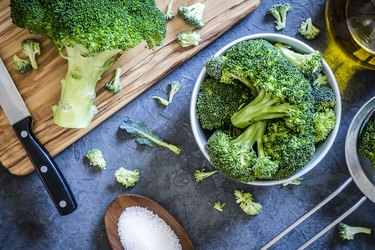 Broccoli stems and other commonly-wasted "trim" are tasty and nutritious. Image Credit: carlosgaw/E+/GettyImages
Broccoli stems and other commonly-wasted "trim" are tasty and nutritious. Image Credit: carlosgaw/E+/GettyImages
8. Learn to Store Foods Properly
One more pro tip: Foods have different storage requirements, and learning what they are can help you maximize the storage life of your perishables. Some do best in the fridge and others on the counter; some need it dry while others appreciate the humid environment of a crisper drawer. You can find charts online from government or extension sources to help you navigate your foods' needs, or use the FDA's FoodKeeper app. It's also useful to know how best to arrange things in your fridge for food safety, so you don't accidentally cross-contaminate vulnerable foods.
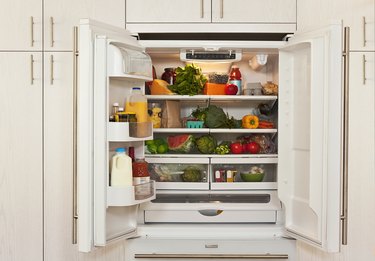 Knowing what conditions your foods prefer can help prevent waste. Image Credit: Karen Moskowitz/The Image Bank/GettyImages
Knowing what conditions your foods prefer can help prevent waste. Image Credit: Karen Moskowitz/The Image Bank/GettyImages
9. Confirm Your Fridge's Temperature
Whether your fridge has digital high-tech temperature setting or an old-school dial, its whole purpose is to keep your foods at a safe temperature of no more than 40 degrees Fahrenheit. For the most part they do that job reliably, but it's smart to monitor your fridge temperature anyway (restaurants are required to do this, by law). Pick up a few inexpensive thermometers and put them in various places in your fridge — high and low, front and back — and then check periodically to make sure they're all in that 32- to 40- degree range, and ideally between 34 and 38 degrees. If not, adjust the settings or rearrange your foods to improve air flow. You'll find your food "magically" starts lasting longer.
 Use a thermometer to verify that your fridge’s temperature is accurate. Image Credit: Carbonero Stock/Moment/GettyImages
Use a thermometer to verify that your fridge’s temperature is accurate. Image Credit: Carbonero Stock/Moment/GettyImages
10. Start Composting Food Waste
Waste reduction with non-food items is summarized as "reduce, reuse and recycle." For food, composting is how we can recycle. If you live an an area with municipal composting, buy (or request, sometimes they're provided) a small in-kitchen collector bin and start using that for your trim, peels and produce scraps. Some programs also accept animal-based waste such as bones, fat, dairy and eggs, but others don't (just ask). If you have a house and a garden, you'll have the option of composting your own kitchen and yard waste to make a high-value amendment for your own soil. That in turn can help you grow more of your own food, which is the best way of all to reduce food waste.
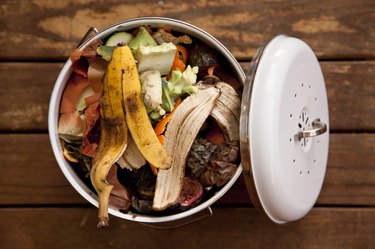 Composting is the food equivalent of recycling. Image Credit: Jenny Dettrick/Moment/GettyImages
Composting is the food equivalent of recycling. Image Credit: Jenny Dettrick/Moment/GettyImages



























